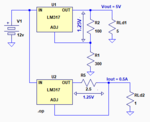syeda amna
Full Member level 4
Hello,
Can anybody explain constant current mode and constant voltage mode in LM317.
I have read Vin>Vout, Vin must be 3V higher than Vout, In this case we get the regulation property.
Can anybody explain constant current mode and constant voltage mode in LM317.
I have read Vin>Vout, Vin must be 3V higher than Vout, In this case we get the regulation property.
